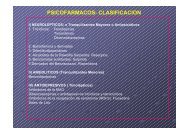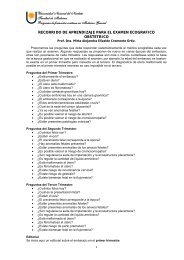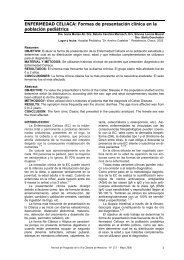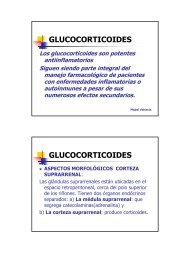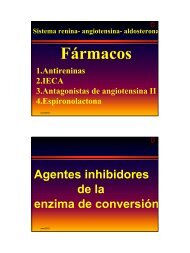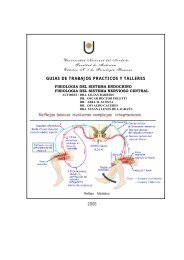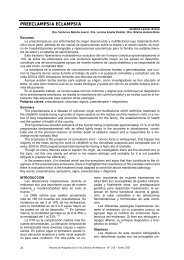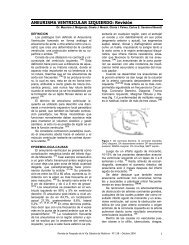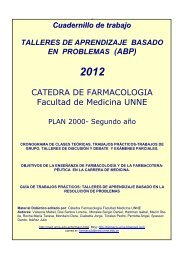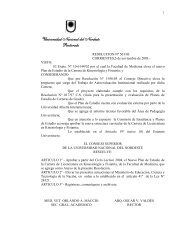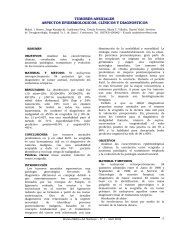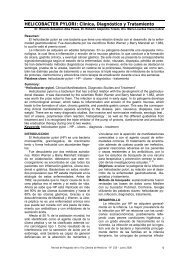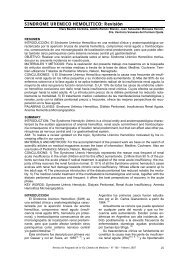Suplemento 2011 - Facultad de Medicina - Universidad Nacional ...
Suplemento 2011 - Facultad de Medicina - Universidad Nacional ...
Suplemento 2011 - Facultad de Medicina - Universidad Nacional ...
You also want an ePaper? Increase the reach of your titles
YUMPU automatically turns print PDFs into web optimized ePapers that Google loves.
PRIMER PREMIO<br />
Canale L. Hernán y Col. Rev. Fac. Med. UNNE XXXI: Supl., 7 - 10, <strong>2011</strong><br />
Evaluación <strong>de</strong> una dieta rica en grasa bovina<br />
sobre el perfil lipídico en ratones<br />
Hernán L. Canale*; Víctor A. Díaz Espinoza; Ricardo N. Perez; Celina M. Scapini; Cecilia Cremer<br />
Laboratorio <strong>de</strong> Fisiología, CInByC, <strong>Facultad</strong> <strong>de</strong> Ciencias Médicas, <strong>Universidad</strong> <strong>Nacional</strong> <strong>de</strong>l<br />
Comahue, Irigoyen 2000, Cipolletti, Río Negro<br />
E-mail: hernancanale@live.com<br />
Efecto <strong>de</strong> grasa bovina sobre perfil lipídico <strong>de</strong> ratones<br />
Las plantas medicinales cumplen un rol importante<br />
en la atención primaria <strong>de</strong> la salud en las comunida<strong>de</strong>s <strong>de</strong> la<br />
norpatagonia, y en el marco <strong>de</strong>l proyecto <strong>de</strong> investigación se<br />
propone conocer la bioactividad <strong>de</strong> las especies autóctonas,<br />
particularmente aquellas vinculadas a usos como hipoglucemiantes<br />
e hipolipemiantes. A partir <strong>de</strong>l relevamiento <strong>de</strong> las<br />
plantas se i<strong>de</strong>ntificó al neneo (Mulinum spinosum) que se<br />
utiliza popularmente como tratamiento para “bajar el azúcar y<br />
las grasas <strong>de</strong> la sangre”. Con el fin <strong>de</strong> evaluar la posible acción<br />
reguladora sobre el metabolismo lipídico <strong>de</strong> M. spinosum se<br />
planteó el objetivo <strong>de</strong> generar un mo<strong>de</strong>lo <strong>de</strong> ratón hiperlipidémico,<br />
a partir <strong>de</strong> la modificación en su dieta.<br />
Se utilizaron ratones macho BalbC alimentados con<br />
una dieta suplementada con grasa bovina durante un periodo<br />
<strong>de</strong> 30 días. Al término <strong>de</strong>l tratamiento se evaluaron los parámetros<br />
anatómicos y bioquímicos relacionados con el perfil<br />
lipídico. El grupo tratado con dieta rica en grasa mostró<br />
valores <strong>de</strong> triglicéridos significativamente superiores a los <strong>de</strong>l<br />
control, tratado con dieta comercial. Ni el peso corporal ni el<br />
hepático se modificaron, tampoco la glucemia, hematocrito,<br />
colesterol total, HDL ni LDL.<br />
Si bien podría esperarse un aumento <strong>de</strong> los niveles<br />
<strong>de</strong> colesterol, ya que la grasa vacuna contiene aproximadamente<br />
un 70% <strong>de</strong> grasas saturadas, la hipertrigliceri<strong>de</strong>mia generada<br />
se <strong>de</strong>bería al alto porcentaje <strong>de</strong> acido esteárico que contiene la<br />
grasa bovina, que no eleva los niveles plasmáticos <strong>de</strong> colesterol<br />
total, a diferencia <strong>de</strong> los ácido mirístico y laúrico.<br />
<strong>Medicina</strong>l plants have an important role in PHA<br />
(primary health attention) in nor-Patagonian communities, and<br />
as a part of the investigation project, it is proposed to study the<br />
bioactivity of autochthonous species especially the ones<br />
related to a hypoglycemic and hypolipemic use. Based on the<br />
plants surveyed, neneo (Mulinum spinosum) was i<strong>de</strong>ntified as<br />
a popularly used treatment to “lower the sugar and fat levels in<br />
blood”.<br />
So as to evaluate the possible regulatory effect of<br />
M. spinosum on lipid metabolism, it was proposed to generate<br />
an hyperlipi<strong>de</strong>mic mouse mo<strong>de</strong>l by modifying its diet. Balb-c<br />
male mice were fed with a diet enriched with bovine fat during<br />
30 days. At the end of the treatment several anatomic and<br />
biochemical parameters were measured. The group treated<br />
with the bovine fat-rich diet showed significantly higher levels<br />
of triglyceri<strong>de</strong>s than the control group which received<br />
commercial diet. The body and hepatic weight were not modified,<br />
nor were the glycemia, hematocrit, total cholesterol,<br />
HDL-cholesterol and LDL-cholesterol.<br />
As bovine fat contains approximately a 70 % of<br />
saturated fat, it could be expected an increase in total cholesterol<br />
levels; however, the observed hypertriglyceri<strong>de</strong>mia could<br />
have been due to the high proportion of estearic acid in the<br />
bovine fat, which does not increase cholesterol levels, in<br />
contrast with myristic or lauric acids.<br />
Palabras clave: dieta, grasa bovina, perfil lipídico.<br />
Key words: diet – bovine fat – lipemic profile<br />
7



